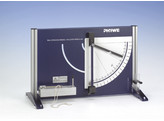Principle
A classic method of determining the velocity of a projectile is to shoot the projectile into a resting mass which is large compared to the projectile's mass and hung as a pendulum. In the process, the projectile remains in the pendulum mass and oscillates with it. This is an inelastic collision in which the momentum remains unchanged. If the pendulum's mechanical data are known, one can infer the velocity of the pendulum's mass (including the projectile's mass) at the lowest point of the pendulum's oscillation from the amplitude of the pendulum's oscillation. The momentum of the two masses in this phase of the oscillation must thus be equal to the impulse of the projectile before it struck the pendulum. If one knows the masses of the pendulum and the projectile, one can calculate the projectile's velocity. In order to be able to use this measuring principle without danger, the following set-up is used here: A steel ball is shot at the mass of a pendulum with the aid of a spring catapult. The pendulum mass has a hollow space in which the steel ball is held. If, additionally, two light barriers and a time measuring device are available, an independent, direct measurement of the initial velocity of the ball can be made.
Tasks
Measurement of the oscillation amplitudes of the ballistic pendulum after capturing the steel ball for the three possible tension energies of the throwing device.
Calculation of the initial velocities of the ball from the measured oscillation amplitudes and the mechanical data of the pendulum is performed using the approximation formula (3).
Plotting of the velocity v of the steel ball as a function of the maximum deflection; (0.90°) of the pendulum according to formula (3), taking into consideration the special mechanical data of the experiment.
Determination of the correction factor for the utilised pendulum for the conversion of the velocities determined by using the approximation formula into the values obtained from the exact theory. Correction of the velocity values from Tasks 2.5. If the supplementary devices for the direct measurement of the initial velocity are available, measure the initial velocities corresponding to the three tension steps of the throwing device by performing 10 measurements each with subsequent mean value calculation. Plot the measured points in the diagram from Task 3. Give reasons for contingent systematic deviations from the theoretical curve.
What you can learn about
Potential and kinetic energy
Rotational energy
Moment of inertia
Inelastic collision
Principle of conservation of momentum
Angular momentum
Measurement of projectile velocities
Ballistic Unit 11229-10
Ballistic Pendulum,f.Ballist.Unit 11229-20
Speed measuring attachment 11229-30
Power supply 5 VDC/2.4 A 13900-99
Steel ball, d = 19 mm 02502-01
Properties
- PP2131200
- P2131200

